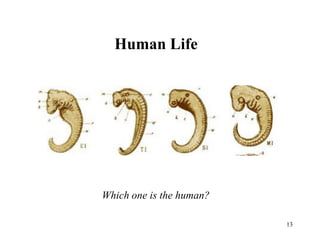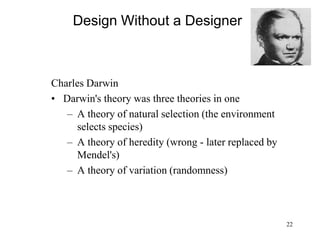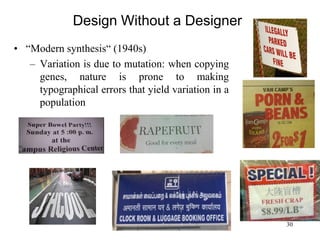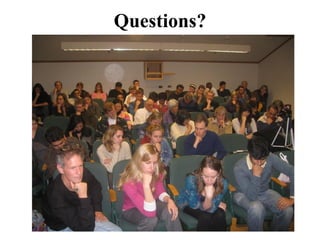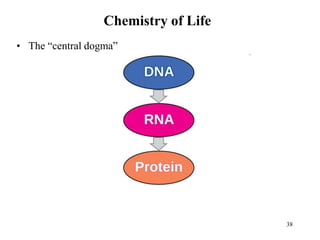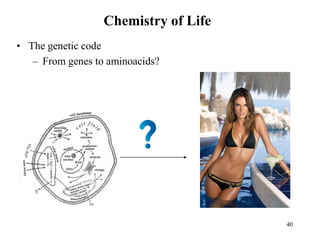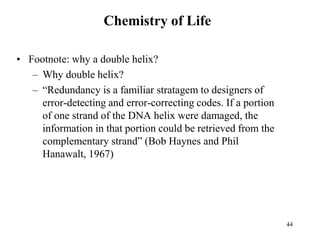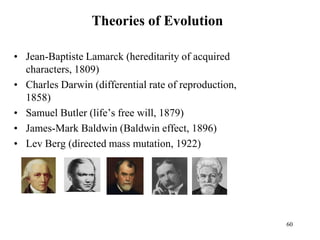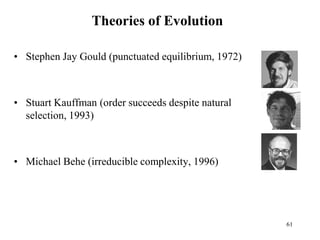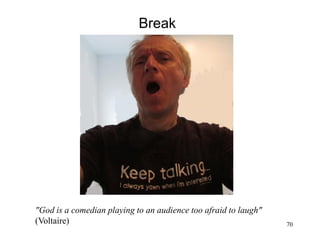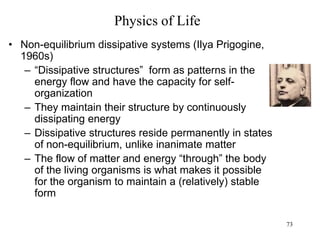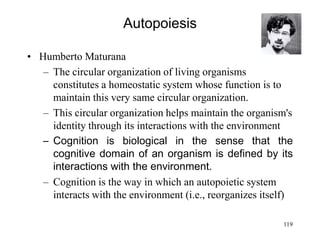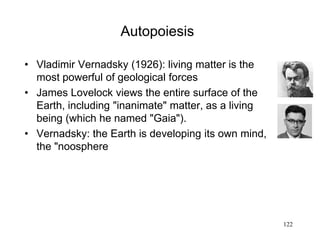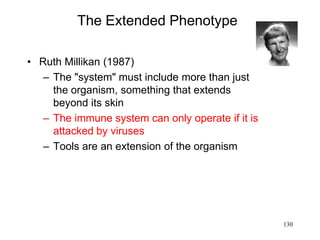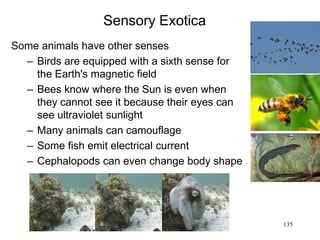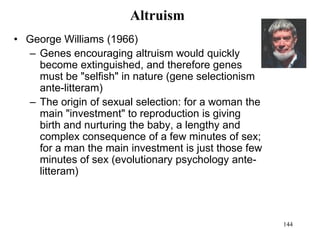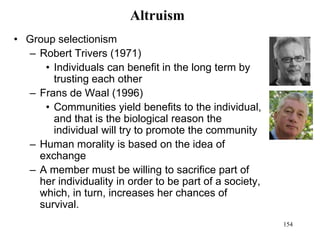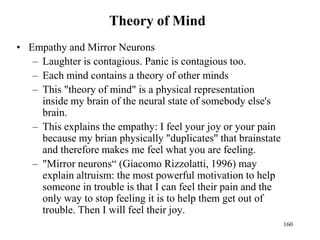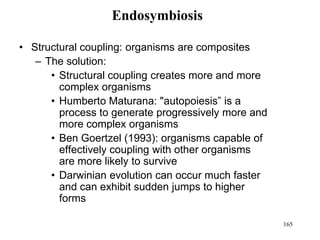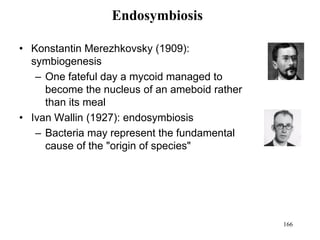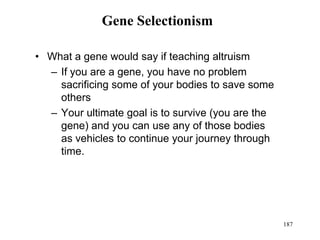Life
- 1. 1 Part 4. Life Thinking about Thought Theories of Brain, Mind, Consciousness May 5, 2015 Piero Scaruffi www.scaruffi.com We are born naked, wet and hungry. Then things get worse. ('One-liner' signature file found on the Internet)
- 2. 2 Why does Life matter? • Only living beings can think • Do all living beings “think”?
- 3. 3 How will extraterrestrial life look like? How will we recognize it as “life”? Christian Nyby: The Thing From Another World (1951) Edgar Ulmer: The Man from Planet X (1951) Jack Arnold: It Came From Outer Space (1953) Steven Spielberg: Close Encounters of the Third Kind (1977) Steven Spielberg: E.T. (1982) Tim Burton: Mars Attacks (1996)
- 4. 4 The Fermi Paradox • Given the probability of exoplanets, the probability of life, the probability of sentient beings, the probability of high technology, etc, the Earth must have been visited many times by aliens • "Where is everybody?" (Enrico Fermi, 1950) • Giuseppe Cocconi and Philip Morrison: "Searching for Interstellar Communications“ (Nature, 1959) • First Search for ExtraTerrestrial Intelligence (SETI) meeting (West Virginia, 1961) • Frank Drake’s equation (1961): number of civilizations in our galaxy with which radio- communication should be possible Unknown:
- 5. 5 Life on Earth • Carbon • Left-handed • DNA • Reproduction • Metabolism • Homeostasis (NASA) A carbon atom has four electrons that can combine with other atoms, usually H, O, N
- 6. 6 Definition of life • Richard Dawkins: – Living beings have to work to keep from eventually merging into their surroundings – There is a natural tendency towards merging seamlessly with the rest of nature. – We have to work in order to maintain our identity. – When we stop working, we die: then we merge with our surroundings. – Living beings are never in equilibrium with their surroundings, unless they are dead
- 7. 7 Definition of life • What is life made of? – All living systems are made of the same fundamental constituents – These molecules cannot move and cannot grow – Still, when they are combined in systems, they grow and move. – New properties emerge. – The first new property is the ability to self-assemble – Eventually we get cells, tissues, organs, bodies, societies…
- 8. 8 Definition of life • Life occurs at three levels: – Phylogenetic: organisms evolve into other organisms – Ontogenetic: each organism changes (or grows) from birth till death – Epigenetic: the behavior of each organism changes during its lifetime (the organism “learns”)
- 9. 9 Definition of life • Life as information – Information that survives from one individual to another ("genotype”) – Information about the individual ("phenotype") – When we say that "ants are alive" (vs stones) and "I am alive" (vs someone who is dead) we mean two different things
- 10. 10 Human Life
- 11. 11 Human Life Embryo’s development Fish, tortoise, chick, rabbit, human?
- 13. 13 Human Life Which one is the human?
- 14. 14 Life
- 15. 15 Questions?
- 16. 16 A brief history of Genetics • 1859: Charles Darwin’s theory of evolution • 1865: Gregor Mendel’s genes • 1920s: Population Genetics (probabilities) • 1940s: Modern Synthesis (variation=mutation) • 1944: Oswald Avery discovers genes are made of DNA • 1953: Francis Crick and James Watson discover the double helix of DNA • 1961: Marshall Nirenberg and Heinrich Matthaei discover how the 4-letter genetic code gets translated into the 20-letter language of proteins • 1965: Robert Holley discovers transfer RNA
- 17. 17 Design Without a Designer DARWIN'S THEORY IS ABOUT SURVIVAL OF THE FITTEST DARWIN'S THEORY IS ABOUT DESIGN
- 18. 18 Design Without a Designer Charles Darwin (1858) • Evolution=variation+selection – Variation is ubiquitous – Natural selection is the driving force of evolution – New species are created by the action of natural selection on variation • Adaptation – New species are caused by the need to adapt to environmental changes • Competition
- 19. 19 Design Without a Designer Charles Darwin • Evolution is the result of inherited differences that occur between one generation and the next • All living beings are the descendants of a simple primeval form of life • The diversity of life and extinct species are explained by evolution
- 20. 20 Design Without a Designer Bacteria, Archaea, Eucaryota You are here
- 21. 21 Design Without a Designer Charles Darwin • Mystery of variation, that appears to be random • Variation can only be treated as a statistical quantity and described statistically • Populations, not individuals
- 22. 22 Design Without a Designer Charles Darwin • Darwin's theory was three theories in one – A theory of natural selection (the environment selects species) – A theory of heredity (wrong - later replaced by Mendel's) – A theory of variation (randomness)
- 23. 23 Design Without a Designer Charles Darwin • Natural selection AND Sexual selection (competition for survival AND competition for reproduction) • Sexual selection: males compete for females, females choose males • Males were the first artists/musicians, females were the first art/music critics
- 24. 24 Design Without a Designer • Designing by trial and error – The offspring is never an exact copy of the parents – The environment (e.g., natural selection) indirectly “selects” which variations (which individuals) survive – Nobody programs the changes in the species – Design emerges spontaneously – Selection = environment – Variation = randomness
- 25. 25 Design Without a Designer • Designing by trial and error – The environment (e.g., natural selection) indirectly “selects” which variations (which connections) survive – Nobody programs the changes in the connections – Design emerges spontaneously – Selection = environment – Variation = randomness
- 26. 26 Design Without a Designer • Designing by trial and error – Natural selection has never produced a clock or even a wheel; but it has produced eyes and brains – Humans can produce clocks, but not eyes or brains – Very complex design can emerge spontaneously via an algorithmic process
- 27. 27 Design Without a Designer • Gregor Mendel (1865) – Traits are inherited as units, not as "blends“ – Each trait is represented by a "unit" of transmission, by a "gene“ – Traits are passed on to the offspring in a completely random manner: any offspring can have any combination of the traits of the parents. – There is a unit of inheritance, later named “gene”
- 28. 28 Design Without a Designer • Sewall Wright and Ronald Fisher: population genetics (1920s) – Darwinism turned into a stochastic theory – Evolution = a shift in gene frequencies within a population over time – Unification of Darwin and Mendel
- 29. 29 Design Without a Designer • “Modern synthesis“ (1940s) – The synthetic theory of evolution merged a theory of inheritance (Mendel’s genetics) and a theory of species (Darwin’s evolutionary biology) +
- 30. 30 Design Without a Designer • “Modern synthesis“ (1940s) – Variation is due to mutation: when copying genes, nature is prone to making typographical errors that yield variation in a population
- 31. 31 Design Without a Designer • Oswald Avery (1944) identifies the the substance that genes are made of, the bearer of genetic information: the deoxyribonucleic acid (DNA) • Francis Crick and James Watson (1953) discover the double-helix structure of the DNA molecule • Genetic information is encoded in a mathematical form, the “genetic code” • DNA is made of four kinds of nucleotides, proteins are made of twenty types of aminoacids • Francis Crick (1957) concludes that information must flow only from the nucleid acids to proteins, never the other way around.
- 32. 32 Design Without a Designer • Sydney Brenner and Francois Jacob (1961) discover that cells of ribonucleic acid (messenger RNA) carry the genetic instructions from the DNA to the ribosomes, the sites within a cell that manufacture proteins. • Francois Jacob and Jacques Monod (1961) discover the mechanism of gene regulation: genes are organized in a network. • Marshall Nirenberg and Har Gobind Khorana (1961) crack the "genetic code“: how the 4-letter language of DNA is translated into the 20-letter language of proteins • Robert Holley discovers transfer RNA (1965), that mediates the translation of the RNA alphabet into the protein alphabet
- 33. 33 Design Without a Designer • Evolution as pattern theory – Reproduction. Copies are made of the pattern. – Variation. Random errors appear in the copies and yield variants. – Selection. The environment selects which variants survive. • Each generation copes better with the environment. • Other factors may accelerate evolution: sex, learning, …?
- 34. 34 Questions?
- 35. 35 Origins • The birth of the first cell is just statistically impossible • Graham Cairns-Smith calculated the probability of all the events required to create a DNA molecule and concluded that there wasn’t enough matter or time in the universe to achieve it
- 36. 36 Origins • Primordial Soup (Stanley Miller, 1953) • Panspermia (Svante Arrhenius, 1903 - John Oro, 1961) • Autocatalytic Loop (Manfred Eigen, 1971) • Chance (Jacques Monod, 1971) • Crystals (Graham Cairns-Smith, 1982) • Thermosynthesis (Anthonie Muller, 1983) • Surface Metabolism (Gunter Waechtershauser, 1988) • Necessity (Harold Morowitz, 1992) • Self-organization (Stuart Kauffman, 1993) • CHNOPS (Christian DeDuve, 1995) • Heat bath (Jeremy England, 2013)
- 37. 37 Origins 1. An organism became capable of generating another organism of the same type 2. Two organisms engaged in sexual reproduction to generate an organism of the same type 3. Organisms became complex assemblies of cells 4. Some of those cells developed into specialized organs 5. A central nervous system developed to direct the organs 6. Mind and consciousness appeared 7. (Next?)
- 38. 38 Chemistry of Life • The “central dogma”
- 39. 39 Chemistry of Life • The genetic code – An organism is a set of cells – Every cell of an individual contains the DNA molecule for that individual, or its "genome“ – Bodies are made of proteins – A protein is made of aminoacids – There are 20 kinds of aminoacids
- 40. 40 Chemistry of Life • The genetic code – From genes to aminoacids?
- 41. 41 Chemistry of Life • The genetic code – A DNA molecule is made of two strings, or "strands", each one the mirror image of the other ("double helix") – Each string is a sequence of "nucleotides" or "bases", which come in four kinds (adenine, guanine, cytosine, thymine) – Nucleotides are the elementary unit of the "genetic code" – These four chemical units constitute the alphabet of the genetic code – The genetic code: translating the 4-letter alphabet of DNA into the 20-letter alphabet of proteins (bases into amino acids)
- 42. 42 Chemistry of Life • DNA-RNA-Protein – The one-dimensional string of instructions of the DNA is used to determine the three-dimensional shape of a protein.
- 43. 43 Chemistry of Life • The genetic code – DNA is the master blueprint for the production of proteins and for the replication of itself
- 44. 44 Chemistry of Life • Footnote: why a double helix? – Why double helix? – “Redundancy is a familiar stratagem to designers of error-detecting and error-correcting codes. If a portion of one strand of the DNA helix were damaged, the information in that portion could be retrieved from the complementary strand” (Bob Haynes and Phil Hanawalt, 1967)
- 45. 45 Chemistry of Life • mRNA – 4 nucleotides arranged in trios (codons) each corresponding to one of the 20 aminoacids
- 46. 46 Chemistry of Life • The genome – The genome is organized into chromosomes (23 pairs in the case of the human race) – Chromosomes are organized into genes – A gene is a section of the DNA molecule which instructs the cell to manufacture proteins (indirectly, a gene determines a specific trait of the individual) – Genes vary in size, from 500 bases long to more than two million bases
- 47. 47 Chemistry of Life • The genome – Humans have about 20,000 genes, only six times more than the Escherichia Coli bacterium – Chimpanzees share 98.6% of the human genome – 98% of the human genome contains the same DNA found in most other vertebrates – Our genome has only 20,000 genes, but our body has 100,000,000,000,000 (100 trillion) cells.
- 48. 48 Chemistry of Life • Trivia: estimates of human genes over the years – 1960s: 2 million genes – 1999: 100,000 – 2001: 30,000 – 2004: 24,500 – 2007: 20,500 – 2014: 19,000 • While it takes a lot of neurons to create the complexity of the brain, it takes very few genes to create the complexity of the body
- 49. 49 Chemistry of Life • The genome – The genome is not a sequential program, that is executed mechanically one gene after the other. It is more like a network of genes that "regulate" each other. – The genetic "program" behaves more like a network of switches.
- 50. 50 Chemistry of Life • Network of genes http://www.pnas.org
- 51. 51 Chemistry of Life • The genome – All living organisms use DNA to store hereditary information and they use the exact same code (the "genetic" code) to write such information in DNA – The smallest genome that is known is the genome of the Mycoplasma Genitalium: 470 genes – Highest number of genes: Daphnia Pulex, 31,000 genes – Longest genomes: Amoeba Dubia (200 times longer than the human genome), Paris Japonica (50 times)
- 52. 52 Chemistry of Life • The genome – Genotype is the "genetic makeup" of the organism. The organism itself is the “phenotype”. – The phenotype is the physical manifestation of the genotype (the "body").
- 53. 53 Chemistry of Life • The cell – Cell membrane – Nucleus: site where DNA is transcribed into RNA – Ribosome: site where creation of proteins takes place – Cytoplasm
- 54. 54 Chemistry of Life • The cell – The cell’s cytoskeleton is made of tubulin proteins, which form cylinders called "microtubules”
- 55. 55 Chemistry of Life • The cell
- 56. 56 Chemistry of Life • The cell – "Cell differentiation": each cell "expresses" only some of the genes in the genome – The human body has about 265 different cell types. – Differentiation regulated by topology: depending on where a cell is, it exchanges energy (which is information) with some cells rather than others. – Stem cell = unspecialized cell The cells of the 3- to 5-day-old embryo (blastocyst) generate all the specialized cell types (heart, lungs, skin, etc)
- 57. 57 Chemistry of Life • The matter of life – Life on Earth is based on the element carbon. – Carbon can bond with oxygen, hydrogen and nitrogen because of its four valence electrons – Both proteins and nucleic acids (DNA, RNA) are made of carbon – Energy is stored in the form of carbohydrates
- 58. 58 Chemistry of Life • Life on Earth uses carbon-based molecules and a base-4 genetic code • Is it possible for a living being from another planet to be made of something else and be encoded in a different kind of code? • Humans have built robots made mostly of metal and copper that are capable of reproducing, growing, communicating, exploring Mars, driving on the highway…
- 59. 59 Questions?
- 60. 60 Theories of Evolution • Jean-Baptiste Lamarck (hereditarity of acquired characters, 1809) • Charles Darwin (differential rate of reproduction, 1858) • Samuel Butler (life’s free will, 1879) • James-Mark Baldwin (Baldwin effect, 1896) • Lev Berg (directed mass mutation, 1922)
- 61. 61 Theories of Evolution • Stephen Jay Gould (punctuated equilibrium, 1972) • Stuart Kauffman (order succeeds despite natural selection, 1993) • Michael Behe (irreducible complexity, 1996)
- 62. 62 Theories of Evolution • Why we have sex – Sex increases variation and therefore the chances of surviving changes in the environment (August Weismann, 1889) – Basically, sex accounts for faster rates of adaptation – Sex is a trade-off: a genome sacrifices a part of its genes to team up with another genome and increase its chances of survival in the environment – Lynn Margulis: once upon a time "eating and mating were the same"
- 63. 63 Theories of Evolution • Why we have to die – A stable immutable form of life would have scant chances of surviving the continuous changes in the environment – A form of life that continuously reshapes itself has a chance to “evolve” with the environment – Lynn Margulis: "death was the first sexually- transmitted disease“
- 64. 64 Identity • There are ~100 trillion cells in your body (of which 100 billion neurons) • Cells reproduce by dividing - they produce clones of themselves (mitosis) • Cellular longevity cap: the "Hayflick limit“: human cells can only double ~50 times before they stop reproducing (Leonard Hayflick & Paul Moorhead, 1961) • Yes, the Hayflick limit keep us from living forever
- 65. 65 Identity • Programmed cell death (apoptosis) is a clockwork process of replacement of cells for the good of the organism (John Kerr, Alastair Currie & Andrew Wyllie, 1972) • Apoptosis is the main deterrent against cancer (“immortality” of cells would increase the chances of cancer)
- 66. 66 Identity • The intelligence of the body: It builds itself from 1 cell into 100 trillion cells in 9 months, and it rebuilds 98% of itself in less than a year • Your body is younger than you think: the average age of all the cells in an adult's body is 7 to 10 years (Jonas Frisen, 2005) • Every year about 98% of the atoms in your body are replaced
- 67. 67 Identity • You are physically someone else… • Good news: neurons in the cerebral cortex are not replaced - your neurons are the oldest cells in your body • Bad news: many neurons die and are never replaced, hence you have fewer neurons than when you were a child.
- 68. 68 Identity • There are 10 times more bacterial cells in your body than human cells (bacteria are far smaller than human cells) - 500 species in the intestine alone (Human Microbiome Project, 2012) • Where they came from: your mother's uterus, your mother’s milk, natural water, food, air… • What they do: help your immune systems and your digestion (“commensal bacteria”) • “Human bodies are an assemblage of life-forms living together” (David Relman, Stanford, 2012)
- 69. 69 Questions?
- 70. 70 Break "God is a comedian playing to an audience too afraid to laugh" (Voltaire)
- 71. 71 Physics of Life • Second law of Thermodynamics – Entropy: a measure of disorder – Disorder must always increase. Physical systems decay. • But… – Life creates order: biological systems appear from nowhere, organize themselves, grow, reproduce • Two arrows of time: – Physical systems decay – Biological systems grow and evolve
- 72. 72 Physics of Life • Negentropy (Erwin Schrodinger, 1944) – Living systems exist in a flux of energy – The existence of a living organism depends on increasing the entropy of the rest of the universe.
- 73. 73 Physics of Life • Non-equilibrium dissipative systems (Ilya Prigogine, 1960s) – “Dissipative structures” have the capacity for self-organization – They maintain their structure by continuously dissipating energy – Dissipative structures reside permanently in states of non-equilibrium, unlike inanimate matter – The flow of matter and energy “through” the body of the living organisms is what makes it possible for the organism to maintain a (relatively) stable form – Equilibrium is death, non-equilibrium is life
- 74. 74 Physics of Life • Non-equilibrium dissipative systems (Ilya Prigogine, 1960s) – In order to stay alive, they have to be always in this state far from equilibrium. – An organism "lives" because it absorbs energy from the external world and processes it to generate an internal state of lower entropy. – An organism "lives" as long as it can avoid falling in the equilibrium state (maximum entropy) – Equilibrium is death, non-equilibrium is life.
- 75. 75 Physics of Life • Non-equilibrium dissipative systems Information dynamics
- 76. 76 Physics of Life • Daniel Brooks and Edward Wiley (1988) – “Dollo's law” states the irreversibility of biological evolution: evolution never repeats itself – Dollo's law is the biological manifestation of the second law of Thermodynamics
- 77. 77 Physics of Life • Eric Schneider (1992) – A system pushed away from its attractor by a gradient, will tend to return to the attractor – The stronger the push, the stronger the reaction, the reaction being some form of self-organization – When the gradient pushing the system is particularly strong, the system may self- organize in ever more complex structures – “Nature abhors a gradient”
- 78. 78 Physics of Life • Alfred Lotka (1920s) – Ecosystems are networks of energy flows • Eugene Odum (1953) – The entire Earth is a set of interconnected ecosystems • Harold Morowitz (1968) – Flows of energy organize systems • Jeffrey Wicken (1987) – “Thermodynamics is above all the science of spontaneous processes”
- 79. 79 Physics of Life • Bio-information theories – Ecosystem = cybernetic system (Ramon Margalef, 1968) – Life = a combination of metabolism and information control (Tibor Ganti, 1971) – Life = pattern (Gregory Bateson, 1979) – In living systems the manipulation of information prevails over the manipulation of energy (Chris Langton, 1989) – Biosystem = information processor (Lionel Johnson, 1998)
- 80. 80 Physics of Life • David Layzer (1968) – In an expanding universe the potential entropy increases faster than energy and matter can “use”, making room for the growth of order
- 81. 81 Physics of Life • Ronald Fox (1988) – The interaction between organism and environment as well as the interaction among organisms are nonlinear in nature – The nervous system is not only capable of predicting the outcome of linear situations, but also of predicting the much more important outcome of nonlinear situations – The reason is that the nervous system allows the organism to rapidly simulate the outcome of nonlinear events
- 82. 82 Summary • From Bioenergetics to the Brain – Life is about flows of energy – Thermodynamics is the discipline that studies energy – Life requires a new kind of Thermodynamics: non- equilibrium Thermodynamics – Non-equilibrium Thermodynamics has to do with non- linear systems – Survival requires the ability to predict what will happen to the system – If the system is non-linear, no mathematical prediction is possible: the only way to predict is to simulate the system at a higher speed – The brain is a simulation machine of nonlinear systems
- 83. 83 Questions?
- 84. 84 Origin of Form • Morphogenesis – During development, cells split and split and split – Every time a cell splits, the new cells inherit (almost) exactly the same genes – But then some cells become blood cells and some cells become bone cells and some cells become … – If they run the same program, how come that two cells become two different things? – And how do they know the position where those two things have to be?
- 85. 85 Origin of Form • Morphogenesis – Zebras have black and white stripes: how do those cells know that they have to be white or black? – A body is shaped by the orderly movement of billions of cells to the locations that specify their role
- 86. 86 Origin of Form • Morphogenesis – What determines which genes are switched on and off in a given cell? – How do "regulatory" genes know that a cell has to become part of a hair rather than a liver?
- 87. 87 Origin of Form • Vitalism – Paul Weiss (1939) and Hans Speman (1938): "organizing fields" help organisms take their shape – Conrad Waddington (1957): "chreodes“ (a mathematical formalization of organizing fields) and the "epigenetic landscape“ – Ralph Abraham (1976): "macrons“ (collective vibrational patterns) are ubiquitous in nature (in solids, liquids, gases) – Paul Davies (1999): the “life force” is a kind of software program (information is traded by “informational” forces the same way that matter is traded by physical forces)
- 88. 88 Origin of Form • Vitalism – Donald Ingber (1993) • “Tensegrity" structures share the property of optimizing structural stability • Living systems, at all hierarchical levels, stabilize through the interplay of two forces, one which is tensional and one which is compressive • Buckminster Fuller ‘s geodesic dome: the geometry of the components constrains the Physics of the components, thereby immobilizing the whole structure • Tensegrity structures abound in nature, from the cytoskeleton to carbon atoms
- 89. 89 Origin of Form • Vitalism – Susan Oyama (1985) • The form of an organism cannot be transmitted in genes or contained in the environment • Form is the result of interactive construction, not the outcome of a preexisting plan • An organism inherits its environment, as much as it inherits its genotype • It inherits some competence, but also the stimuli that make that competence significant
- 90. 90 Questions?
- 91. 91 Bibliography • Crick, Francis: Astonishing Hypothesis (Macmillan, 1993) • Dawkins, Richard: The Blind Watchmaker (Norton, 1987) • Deduve, Christian: Vital Dust (Basic, 1995) • Dennett, Daniel: Darwin's Dangerous Idea (Simon & Schuster, 1995) • Deutsch David: The Beginning Of Infinity (Viking, 2011) • Dyson, Freeman: Infinite In All Directions (Harper & Row, 1988) • Fisher, Ronald Aylmer: The Genetical Theory Of Natural Selection (Dover, 1929) • Fox Ronald: Energy And The Evolution Of Life (Freeman, 1988) • Gould, Stephen Jay: Ever Since Darwin (Deutsch, 1978) • Kauffman, Stuart: The Origins Of Order (Oxford University Press, 1993) • Mayr, Ernst: Animal Species And Evolution (Harvard Univ Press, 1963) • Morowitz, Harold: Energy Flow In Biology (Academic Press, 1968) • Morowitz, Harold: Entropy And The Magic Flute (Oxford University Press, 1993) • Weber, Bruce, Depew David & Smith James: Entropy, Information And Evolution (Mit Press, 1988)
- 92. 92 Ecological Realism: The Embodied Mind "Life is what happens to us while we are making other plans" (Allen Saunders, 1957)
- 93. 93 Ecological Realism: The Embodied Mind • Is a transcendental disembodied mind possible? • The brain is in the body, and the body is in the world • Life is a continuously changing equilibrium between an organism and its environment • The brain is one of the many organs that help an organism survive in the environment • “Cognition” is about the interaction between organisms and their environment
- 94. 94 Ecological Realism: The Embodied Mind • Minsky and Searle: “Brains cause minds. Mind is what happens to brains.” • How about: “Bodies cause minds. Mind is what happens to (some) bodies?”
- 95. 95 Ecological Realism: The Embodied Mind • Empiricism: All knowledge comes from experience (e.g., 20th century behaviorists) • Plato: All knowledge comes from reasoning • Kant: Perception is shaped by innate knowledge (space, time, cause/effect, etc) • Helmholtz: Perception is a mere hypothesis on what the world is • Ecological realism: our senses, shaped by natural evolution, don't tell us what the world is really like but simply what needs to be known for surviving and reproducing • Perception is an active process
- 96. 96 Ecological Realism: The Embodied Mind • The mind operates in a world that is the outcome of the body’s experience • Jakob von Uexküll (1934) – The “umwelt” of a species is the set of all possible stimuli from the environment that the species can perceive plus all possible actions that the species can perform in the environment. – A species’ reality is confined in its umwelt – Each species grasps reality differently because it lives inside a different umwelt.
- 97. 97 The Information Flow • James Jerome Gibson (1966): Cognition – Cognition “is” the interaction between living beings and the environment – The process of perceiving is a process of picking up information that is available in the environment – Information originates from the interaction between the organism and its environment – Information = continuous energy flow of the environment – Cognition is the information flow
- 98. 98 The Information Flow • James Jerome Gibson: Action and perception – Cognitive life is passive, not active: the organism is free to move in the world, but it is the environment that feeds it information – The way this information is "processed" is direct: there is no mediation by the mind – The sensory data coming from the environment already contain all the relationships needed to navigate the environment. – Action follows perception, and the two can be viewed as dual aspects of the same process.
- 99. 99 The Information Flow • James Jerome Gibson: information patterns – What the brain truly does is recognize the information that matters. – The information that matters is patterns: any pattern of environmental stimuli that repeats itself over time constitutes "information". – Our brain is an organ capable of discovering "invariants" in the environment
- 100. 100 The Information Flow • James Jerome Gibson: Perception – Detecting the invariants of the environment – A continuously ongoing process – The function of the brain is to orient the organs of perception for seeking information – There is much more information in the world and less in the head – The environment does most of the work that we traditionally ascribe to the mind
- 101. 101 The Information Flow • Ulric Neisser (1975): Cognition – Cognition is the skill of dealing with knowledge that comes from the environment – The mind developed to cope with that knowledge – Directionality of exploration by the organism: the organism is not completely passive in the hands of the environment, but somehow it has a cognitive apparatus that directs its search for information
- 102. 102 The Information Flow • Ulric Neisser: Cognition – The brain “knows” in advance which objects are more likely to be “seen” in a certain situation – "We can see only what we know how to look for" – Schemas express the direct relation between action and perception – A schema is a blueprint for what information the organism presumes to encounter and what it entails in the environment
- 103. 103 The Information Flow • Ulric Neisser: Perception – Perception/cognition transforms the perceiver: an organism "is" the cognitive acts it engages in
- 104. 104 Philosophical Variants • Fred Dretske (1981) – Information is in the environment and cognitive agents simply absorb it, thereby creating mental states • Daniel Dennett – The organism continuously reflects its environment – The organization of its system implicitly contains a representation of the environment
- 105. 105 Impact of Ecological Realism • Reversal of the traditional role between the organism and the environment: the organism not as an actor but as a “reactor” • Generalization of the concept of cognitive system: any living being can be considered, to some extent, a cognitive system • A living organism is a part of the world capable of perception and action
- 106. 106 Situated Cognition • Rodney Brooks (1986) – Robot = situated agent – Interaction between an agent and its environment. – Situated agents have no knowledge (unlike expert systems) – The world contains all the information that the organism needs, therefore there is no need to represent it in the mind – The environment acts like a memory external to the organism, from which the organism can retrieve any kind of information through perception
- 107. 107 Situated Cognition • Rodney Brooks Traditional architecture Brooks
- 108. 108 Situated Cognition • Rodney Brooks – Behavior is determined by the structure of the environment • The system decomposes in layers of goal- driven behavior • The system incrementally composes its behavior through the interaction with the world – No difference between perception, reasoning and action – The environment is the center of action, not the mind – The environment is action, continuous action – Cognition is rational kinematics
- 109. 109 Situated Cognition • Rodney Brooks Baxter (2012) (1986)
- 110. 110 Situated Cognition • Valentino Breitenberg (1984) – Vehicles: simple electro-mechanical components – At the beginning, there are only “vehicles” that respond to their environment. – As their circuitry increases, the vehicles seem to exhibit more sophisticated feelings. – Depending on the wiring Vehicle #2 is either "aggressive“ or "afraid". – These vehicles seem to acquire not only new skills, but also a stronger personality. – It is far easier to create machines that exhibit "cognitive" behavior than it is to analyse their behavior and try to deduce the internal structure that produces such behavior
- 111. 111 Situated Cognition • Andy Clark (1997) – We can dispose of the body and still find ways that a brain would calculate how to perform actions – But the very reason that we have bodies is that bodies make it a lot easier to perform those actions even without calculating every single movement – The fact that a body's movements are constrained by the body's structure is actually an advantage: once the brain directs a general action, there are only so many ways that the action can be carried out by the body. – There is no need to calculate ways that are beyond the capabilities of the body.
- 112. 112 Questions?
- 113. 113 Autopoiesis • Humberto Maturana (1970) – The frog sees patterns of small moving shadows and , by reacting to those patterns, catches insects, its food stuff (1959) – "Autopoiesis" is the process by which an organism can continuously reorganize its own structure – Adaptation consists in regenerating the organism's structure so that its relationship to the environment remains constant – Living systems are units of interaction – They cannot be understood independently of their environment – The relationship with the environment molds the configuration of a cognitive system
- 114. 114 Autopoiesis • Humberto Maturana – Living systems are organized in closed loops – Goal: maintaining the circular organization of the whole. – A cell exhibits autopoiesis, as does the Earth as a whole. – Autopoiesis is self-maintenace – The product of a living system is a new organization of itself – A living system continually produces itself – Organisms use energy (mainly from light) and matter (water, carbon, nitrogen, etc) to continuously remake themselves
- 115. 115 Autopoiesis • Humberto Maturana – The circular organization of living organisms constitutes a homeostatic system whose function is to maintain this very same circular organization. – This circular organization helps maintain the organism's identity through its interactions with the environment – Cognition is biological in the sense that the cognitive domain of an organism is defined by its interactions with the environment. – Cognition is the way in which an autopoietic system interacts with the environment (i.e., reorganizes itself)
- 116. 116 Autopoiesis • Humberto Maturana – All living systems are cognitive systems – Action and cognition cannot be separated (”All doing is knowing and all knowing is doing") – Communication is not about transmission of information but rather coordination of behavior among living systems.
- 117. 117 Autopoiesis • Francisco Varela (1979) – The human body is a collection of both matter and experience, both a biological entity and a phenomenological entity – Cognition is embodied action (or "enaction") – The world reflects the actions in which we engage, i.e. it is "enacted" from our actions – Organisms and environment mutually specify each other – Organisms drift naturally in the environment. – Evolution is not optimal adaptation but "natural drift"
- 118. 118 Autopoiesis • Francisco Varela (1999) – “The mind is not in the head" – “The mind is in this non-place of the co- determination of inner and outer, so one cannot say that is outside or inside“ – Mind is "a coherent whole which is nowhere to be found“ – "The mind neither exists nor does it not exist “ – My mind is a "selfless self“
- 119. 119 Hyper-autopoiesis • The biosphere as a whole is autopoietic as it maintains itself through a careful balance of elements • Lynn Margulis: life "is" the surface of the Earth • Vladimir Vernadsky (1926): living matter is the most powerful of geological forces • James Lovelock views the entire surface of the Earth, including "inanimate" matter, as a living being (which he named "Gaia"). • Vernadsky: the Earth is developing its own mind, the "noosphere
- 120. 120 Questions?
- 121. 121 The Extended Phenotype • Richard Dawkins (1982)
- 122. 122 The Extended Phenotype • Richard Dawkins (1982) – The "extended phenotype" includes the world that an organism interacts with – The organism alone does not have biological relevance – What makes sense is an open system made of the organism and its neighbors – The very genome of a species can be viewed as a representation of the environment inside every single cell
- 123. 123 The Extended Phenotype • Richard Dawkins (1982) – The control of an organism is never complete inside and null outside: there is a continuum of degrees of control, which allows partiality of control inside (e.g., parasites operate on the nervous system of their hosts) and an extension of control outside (as in the spiderweb)
- 124. 124 The Extended Phenotype • Ruth Millikan (1987) – The "system" must include more than just the organism, something that extends beyond its skin – The immune system can only operate if it is attacked by viruses – Tools are an extension of the organism
- 125. 125 The Extended Phenotype • Richard Lewontin (1981) – Organisms construct environments that are the conditions for their own further evolution and for the evolutions of nature towards new environments – Organism and environment mutually specify each other – An organism is both the subject and the object of its evolution
- 126. 126 Sensory Exotica Some animals have other senses – The bat can avoid objects in absolute darkness at impressive speeds and even capture flying insects – Dolphins generate their sonar calls also through their nose, besides their larynx – Migratory animals (birds, salmons, whales…) can orient themselves and navigate vast territories without any help from maps – Butterflies take more than a generation to complete the journey, i.e. those who begin the journey are not the ones that reach the destination
- 127. 127 Sensory Exotica Some animals have other senses – Birds are equipped with a sixth sense for the Earth's magnetic field – Bees know where the Sun is even when they cannot see it because their eyes can see ultraviolet sunlight – Many animals can camouflage – Some fish emit electrical current – Cephalopods can even change body shape
- 129. 129 Questions?
- 130. 130 Break "Nature has all the answers, so what is your question?" (Howard Odum)
- 131. 131 Altruism "Hell is other people" (Sartre)
- 132. 132 Altruism • The Veneer Theory of human morality: morality is just a thin veneer over a cauldron of selfish brutal instincts • Darwin’s theory of evolution (“survival of the fittest”) is ultimately about competition for scarce natural resources Competition belongs to a powerful thread of Western thought (Adam Smith, capitalism) Cooperation belongs to a very minor thread of Western thought Cooperation more likely to emerge out of communist and Eastern philosophical backgrounds
- 133. 133 Altruism • Petr Kropotkin (1902) – Animals must be social and moral – Not an individual struggle for survival, but struggle for survival by masses of individuals, a struggle not against each other but a collective struggle against the common enemy, i.e. the environment – Cooperation is more important than competition
- 134. 134 Altruism • Kinji Imanishi (1941) – Darwin was wrong – Cooperation is more important than competition in nature – Individuals form societies and cannot exist outside societies because it is through societies that they can solve the needs required to their survival
- 135. 135 Altruism • George Williams (1966) – An individual's chances of survival are increased by having friends and decreased by having enemies – Evolution has endowed individuals with "altruistic" instincts and emotions because it helps them survive
- 136. 136 Altruism • John Maynard-Smith (1973) – Game theory proves that individuals cooperate not because they share genes but because cooperation is the best strategy
- 137. 137 Altruism • John Maynard-Smith & Eors Szathmary (1993) – Each major transition in evolution affected biological units that were capable of independent replication, and each transition turned them into biological units that needed other biological units in order to replicate • Independently replicating nucleid acids evolved into chromosomes (assemblies of molecules that must replicate together) • Sexless life was replaced by species that have male and female members, and that can replicate only if a male and a female “cooperate” • Ants and bees can only replicate in colonies – Each “major transition” seems to produce cooperation
- 138. 138 Altruism • John Maynard-Smith & Eors Szathmary (1993) – In each major transition, sets of identical biological units were replaced by sets of specialized units that needed to cooperate in order to survive and replicate – A world of multifunctional self-sufficient biological entities evolved into a society of specialized entities – The multifunctional cell led to cellular organization and eventually to bodies with specialized limbs and organs that eventually led to societies of specialists (ants, bees, humans)
- 139. 139 Altruism • John Maynard-Smith & Eors Szathmary (1993) – Division of labor among a group of specialists is more effective than a multifunctional non-specialist but only if the specialists cooperate – Altruism, or at least division of labor and cooperation, appeared very early in the history of life, as soon as molecules were enclosed within membranes.
- 140. 140 Altruism • John Maynard-Smith & Eors Szathmary (1993) – Cooperation is inherent in Mendel’s laws: a gene’s chances of surviving in future generations depends on the success of the cell that hosts that gene, a success that depends on the success of all the other genes that determine the life of that cell – Hence a gene has a vested interest in “cooperating” with the other genes. – The cell would not survive if its genes did not form an efficient society.
- 141. 141 Altruism • Kin selectionism – John Haldane (1955) • Altruism is proportional to genetic proximity • The genetic self-interest of the individual peaks in its own body, but it extends to all of its kin, proportional to how genetically close they are • It is not the survival of the individual that matters: it is survival of as many genes as possible • The individual is programmed to preserve not only itself but also other individuals that share a similar genetic repertory, in a manner proportional to that similarity.
- 142. 142 Altruism • Group selectionism – Vero-Copner Wynne-Edwards (1962) • It is groups (rather than single individuals) that adapt to the environment – David Sloan Wilson (1975) • Groups often behave like organisms • An organism can be viewed as a collection of genes that work together towards maximizing their common chances of survival • "Selfishness beats altruism within groups. Altruistic groups beat selfish groups.”
- 143. 143 Altruism • Group selectionism – Robert Trivers (1971) • Individuals can benefit in the long term by trusting each other – Frans de Waal (1996) • Communities yield benefits to the individual, and that is the biological reason the individual will try to promote the community – Robert Axelrod’s “Tit for Tat” (1981)
- 144. 144 Altruism • Matt Ridley (1993) – Co-evolution with parasites – Evolution is accelerated even by apparent enemies like parasites – Organisms adopted sexual reproduction in order to cope with invasions of parasites: parasites have a harder time adapting to the diversity generated by sexual reproduction, whereas they would have devastating effects if all individuals of a species were identical (if the children were as vulnerable to the same diseases as the parents) – Plants reproduce with the help of insects – The need to fight competition often leads to cooperation
- 145. 145 Summary • The emphasis in evolutionary theories has traditionally been on competition, not cooperation, although it is through cooperation, not competition, that considerable jumps in behavior can be attained. • In a sense, living beings, and humans in particular, have mastered altruism the same way they mastered tools that allowed them to extend their cognitive abilities • Humans are able to deal with large groups of non- relatives • De facto, those individuals are “used” as a tool to augment the mind: instead of having to solve problems alone, the mind can use an entire group.
- 146. 146 Questions?
- 147. 147 Theory of Mind • David Premack and Guy Woodruff (1978) – Children are prewired with the distinction between "minds" and non-minds, i.e. between sentient beings and inanimate matter. – Children treat differently objects that move by themselves and objects that move only when someone moves them. – Children tend to see a "motive" behind self-propelled objects. – It is a built-in ability to guess the state of mind of another being. – Face perception might be the most developed visual skill in humans.
- 148. 148 Theory of Mind • We can't help building theories of mind whenever we look at somebody
- 149. 149 Theory of Mind • Empathy and Mirror Neurons – Laughter is contagious. Panic is contagious too. – Each mind contains a theory of other minds – This "theory of mind" is a physical representation inside my brain of the neural state of somebody else's brain. – This explains the empathy: I feel your joy or your pain because my brian physically "duplicates" that brainstate and therefore makes me feel what you are feeling. – "Mirror neurons“ (Giacomo Rizzolatti, 1996) may explain altruism: the most powerful motivation to help someone in trouble is that I can feel their pain and the only way to stop feeling it is to help them get out of trouble. Then I will feel their joy.
- 150. 150 Theory of Mind • We can't help building theories of mind whenever we look at somebody
- 151. 151 Questions?
- 152. 152 Endosymbiosis • Structural coupling: organisms are composites – Structural coupling creates more and more complex organisms – Humberto Maturana: "autopoiesis” is a process to generate progressively more and more complex organisms – Ben Goertzel (1993): organisms capable of effectively coupling with other organisms are more likely to survive – Darwinian evolution can occur much faster and can exhibit sudden jumps to higher forms
- 153. 153 Endosymbiosis • Konstantin Merezhkovsky (1909): symbiogenesis – One fateful day a mycoid managed to become the nucleus of an ameboid rather than its meal • Ivan Wallin (1927): endosymbiosis – Bacteria may represent the fundamental cause of the "origin of species"
- 154. 154 Endosymbiosis • Lynn Margulis (1966): – Mitochondria (that generate the energy required for metabolism in humans) look like bacteria – Mitochondria have their own DNA, separate from the DNA of the cell – Chloroplasts (that carry out photosynthesis in plant cells) look like bacteria – Bacteria can trade genes – Bacteria can reproduce at amazing rates – Endosymbiosis of bacteria is responsible for the creation of complex forms of life – Our multicellular bodies are amalgams of several different strains of bacteria
- 156. 156 Endosymbiosis • A world of bacteria – Life can be viewed as a plan for bacteria to exist forever – The biosphere is controlled mostly by bacteria – The biosphere is "their" environment, not ours – Even the geology of our planet is due to the work of bacteria (shaped by the work of bacteria over million of years) – We are allowed to live in it, thanks to the work of bacteria, which maintain the proper balance of chemicals in the air
- 157. 157 Endosymbiosis • A world of bacteria – More than 90% of the cells that make up the human body are not human: they are bacteria – Commensal bacteria are vitally important for our survival – There are more than 1000 species of bacteria in the human digestive system alone (and many more in the respiratory system, in the urogenital tract, on the skin, etc) – We are a superorganism, or, at least, a walking and thinking ecosystem
- 158. 158 Endosymbiosis • Luis Villarreal (2004) – A virus is a parasite that comes alive, and replicates, only while it feeds on host cells – The genetic instructions of the virus induce the host cell to manufacture the genes that the virus needs in order to assemble a copy of itself – Their fast replication continuously creates new genes, and that process of gene manufacturing takes place inside another organism – Some of those might get “transferred” permanently to the infected organism – Evolution by viral infection
- 159. 159 Questions?
- 160. 160 Superbeings • Collective beings – Single-celled bacteria form large colonies in countless ecosystems, particularly visible in seaside locations. – Soil amoebae join together in one huge organism that can react quickly to light and temperature to find food supplies. – Sponges are actually collections of single-celled organisms held together by skeletons of minerals – Ants and bees show that the difference between a multi-cellular organism and a society of organisms resides only in the type of internal communication
- 161. 161 Superbeings • Collective beings – Karl Von Frisch (1967) • The individual is an oxymoron: a bee cannot exist without the rest of the colony • The colony, on the other hand, constitutes a complex and precise self- regulating system • The hive exhibits a personality, the individual is totally anonymous
- 162. 162 Superbeings • Collective beings – Lewis Thomas (1974) • "I have been trying to think of the earth as a single organism, but…I cannot think of it this way. It is too big, too complex, with too many working parts….it is most like a single cell.“
- 163. 163 Superbeings • Guy Murchie (1978) – The entire Earth is an organism which uses as food the heat of the sun, breathes, metabolizes – The Earth’s cognition is made of many tiny parts (organisms) that communicate, exchange energy, interact – All living organisms, along with all the minerals on the surface of the Earth, compose one giant integrated system that, as a whole, controls its behavior so as to survive – And so do galaxies – Everything constitutes a living superbeing – The question is not whether there is life outside our planet, but whether it is possible to have "non-life"
- 164. 164 Superbeings • James Lovelock (1979): Gaia – The entire surface of the Earth, including "inanimate" matter, is a living being – There is a gigantic cycle that involves the actions and structure of all matter and eventually yields "life" on this planet – The environment (volcanoes, rocks, sea water, sun, rain) is part of life – At the same time life creates the environment that it needs – Life creates the conditions for its own existence.
- 165. 165 Superbeings • Fritjof Capra (1996): the entire planet is a self- organizing network • Deborah Gordon (1999): ants organize themselves like an organism
- 166. 166 Superbeings • Pierre Teilhard de Chardin (1925) • Vladimir Vernadsk (1926) – "Noosphere“: the Earth is developing its own mind, the "noosphere", the aggregation of the cognitive activity of all its living matter.
- 167. 167 Questions?
- 168. 168 Gene Selectionism • Richard Dawkins (1976) – The gene is the fundamental unit of evolution: genes drive evolution and genes drive behavior – Genes want to live forever – A "replicator" is an entity that copies itself – A "vehicle" is the organism that carries the replicator – A replicator is preserved over time and spread over space
- 169. 169 Gene Selectionism • Richard Dawkins (1976) – Vehicles are merely “tests” of how good that information is – Vehicles are the machines that replicators use to build copies of themselves – Bodies will disappear – Genes have a chance to survive forever – What survives is not my body but my genes – The mind itself is engineered to perpetuate DNA
- 170. 170 Gene Selectionism • Richard Dawkins (1976) – In order to maximize its chances of survival, a gene would cause one of its bodies (one of the bodies that contain that gene) to help its "kin" (bodies with the same gene) – The macroscopic effect would be cooperation among organisms, while at the microscopic level that cooperation is truly an attempt by the gene to outsmart other genes, i.e. it is competition of the most cynical kind
- 171. 171 Gene Selectionism • Helena Cronin (1992) – "I" am not the subject, i am the object
- 172. 172 Gene Selectionism • Matt Ridley (1994) – Sex provides a way for a gene to participate in a lottery a number of times: each body is a participant in the lottery of survival. – The more bodies, the more chances to win the lottery. – Winning this lottery entails some work: creating and maintaining the organism – This work must be done jointly with other genes – Sex is the process by which a gene is chosen to work in a body together with other genes
- 173. 173 Gene Selectionism • I am but a product of my genes • Genes represent a higher force than my will, a force that has been acting for millions of years • Genes tell me what to will • Genes tell me how to interact with other people and with the environment
- 174. 174 Gene Selectionism • What a gene would say if teaching altruism – If you are a gene, you have no problem sacrificing some of your bodies to save some others – Your ultimate goal is to survive (you are the gene) and you can use any of those bodies as vehicles to continue your journey through time.
- 175. 175 Questions?
- 176. 176 Sociobiology • Edward Wilson (1975) – The biological basis of social behavior – Culturgenes – All aspects of human culture and behavior are coded in the genes and have been molded by natural selection – Culture is not unique to humans – A culture expresses itself through its "culturgens“, the cultural equivalent of genes – These are the basic units of inheritance in cultural evolution – Culturgens assemble the mind of an individual
- 177. 177 Evolutionary Psychology Prehistory of Evolutionary Psychology • William Hamilton (1963): The Genetic Evolution of Social Behavior • Angus Bateman (1948): natural selection has determined different male and female behaviors. • George Williams (1966): the "sacrifice" required for reproduction is different for the female and the male • Robert Trivers (1972): the investment required for reproduction (to increase the chances of survival of the offspring) is different between a male and a female, and that accounts for different attitudes towards the other sex and the offspring itself
- 178. 178 Evolutionary Psychology • Robert Wright – Freud's subconscious replaced with Darwin's natural selection as the engine of all adult behavior – Morality is simply the set of rules that increase the odds to pass one's genes to the next generation
- 179. 179 Evolutionary Psychology • Geoffrey Miller (2000) – The human mind is not a problem solver, but as a "sexual ornament". – The human brain's creative intelligence is too much if the only purpose is survival – Survival in the environment does not quite require the sophistication of Einstein's science or Michelangelo's paintings or Beethoven's symphonies – But these are precisely the kind of things that the human brain does a lot better than other animal brains. – The human brain is much more powerful than it needs to be.
- 180. 180 Evolutionary Psychology • Geoffrey Miller (2000) – Sexual selection is not driven by random environmental events but by a deliberate strategy to improve the "genetic quality of the offspring". – Sexual selection is as intelligent as we are, whereas natural selection is hardly intelligent at all – Sexual selection is a form of positive feedback, the kind of process that can explain the explosive growth of the human brain.
- 181. 181 Evolutionary Psychology • Geoffrey Miller (2000) – A fundamental function of the human mind is to display one's fitness to the other sex – Painting, singing and dancing are good indicator of physical and mental fitness, that women recognize, evaluate and reward with sex. – Males need to advertise their genes, and this need drives innovation. – Artistic activities developed because they contributed to sexual selection.
- 182. 182 Evolutionary Psychology • Geoffrey Miller (2000) – Darwin: men compete for women, and women choose men – Ronald Fisher : Evolution favors both pickier females and more attractive males – Sexual selection is a form of positive feedback, the kind of process that can explain the explosive growth of the human brain.
- 183. 183 Questions?
- 184. 184 Memes • Gregory Bateson (1972) – The mind is an aggregate of ideas. – Ideas populate the mind and continuously evolve. Ideas evolve in a Darwinian fashion, the most useful ones surviving while useless ones decay and die away. – The mind is the theater of a natural selection and evolution of ideas. – Our conscious life “is” that evolutionary process.
- 185. 185 Memes • Richard Dawkins (1976) – Meme: the cultural counterpart of the gene – A meme is the unit of cultural evolution, just like a gene is the unit of biological evolution – Ideas exhibit variation (copying with mistakes) and selection (pruning the ineffective ones) – A meme is an idea that reproduces itself like a parasite – When a meme enters a mind, it parasitically alters the mind's process so that a new goal of the mind is to propagate the meme to other minds
- 186. 186 Memes • Richard Dawkins (1976) – Just like genes use bodies as vehicles to spread, so memes use minds as vehicles to spread – Memes form an ecosphere of ideas. – The mind is a machine for copying memes, just like the body is a machine to copy genes
- 187. 187 Memes • Daniel Dennett (1995) – Memes (culture) have created the mind, not the other way around – Just like it is genes that drive evolution, it is memes that drive thought
- 188. 188 Memes • Susan Blackmore (1999) – Each mind is but a meme machine – A "memeplex" is a group of memes that band together for some mutual advantage. – The memeplex as a whole becomes stronger and stronger and each participating meme benefits. – Religions and ideologies are memeplexes. – Minds are invaded by memes all the time – We can never stop thinking. – We do not think, we are thought by the memes that invade us.
- 189. 189 Memes • Robert Boyd and Peter Richerson (1985) – The single most important difference between humans and other species is the ability of transmitting culture – Cultural evolution happens at a much faster pace than genetic evolution
- 190. 190 Memes • William Durham (1991) – Human behavior is due to two main information systems, one genetic and one cultural – Both the genetic system and culture are information systems that instruct phenotypes – Cultural evolution exhibits a unique property: self- selection – The cultural system can influence the direction and rate of its own evolution: memes influence human decisions that influence memes. – The cultural fitness of an “allomeme” (a variant of a meme) depends on the meme itself
- 191. 191 Memes • The body is attacked all the time by viruses • The body is defended by an immune system • Strong immune systems repel most viruses • The mind is attacked all the time by memes (mind viruses) • Is there an immune system for the mind that defends the mind from mind viruses? • Are there stronger “mind immune systems” that protect the mind from memes such as religions, ideologies, pop music, Hollywood movies, …
- 192. 192 Questions?
- 193. 193 Bibliography • Dawkins, Richard: The Blind Watchmaker (Norton, 1987) • Dennett, Daniel: Darwin's Dangerous Idea (Simon & Schuster, 1995) • Gibson, James Jerome: The Ecological Approach To Visual Perception (Houghton Mifflin, 1979) • Margulis Lynn: What Is Life? (Simon & Schuster, 1995) • Maturana, Humberto & Varela Francisco: The Tree Of Knowledge (Shambhala, 1992) • Miller, Geoffrey: The Mating Mind (Doubleday, 2000) • Neisser, Ulric: Cognition And Reality (Freeman, 1975) • Ridley Mark: The Cooperative Gene (Free Press, 2001) • Ridley Matt: Evolution (Blackwell, 1993) • Shlain Leonard: Sex, Time, And Power (Penguin, 2003) • Varela, Francisco, Thompson Evan & Rosch Eleanor: The Embodied Mind (Mit Press, 1991) • Wilson, Edward Osborne: Sociobiology (Belknap, 1975) • Wright, Robert: The Moral Animal (Random House, 1994)













